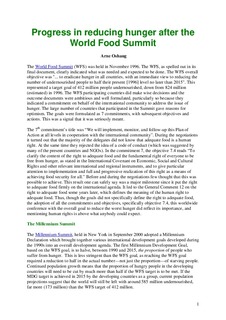| dc.contributor.author | Oshaug, Arne | en_US |
| dc.date.accessioned | 2009-05-06T09:33:33Z | en_US |
| dc.date.accessioned | 2011-12-19T10:52:05Z | |
| dc.date.accessioned | 2020-08-28T08:12:23Z | |
| dc.date.accessioned | 2021-04-29T10:45:54Z | |
| dc.date.available | 2011-12-19T10:52:05Z | |
| dc.date.available | 2020-08-28T08:12:23Z | |
| dc.date.available | 2021-04-29T10:45:54Z | |
| dc.date.issued | 2009 | |
| dc.identifier.citation | Hunger Notes Online. 2009 | |
| dc.identifier.uri | http://idtjeneste.nb.no/URN:NBN:no-bibsys_brage_9081 | |
| dc.identifier.uri | https://hdl.handle.net/20.500.12199/186 | |
| dc.identifier.uri | https://www.worldhunger.org/progress-reducing-hunger-world-food-summit/ | |
| dc.description.abstract | The World Food Summit (WFS) was held in November 1996. The WFS, as spelled out in its
final document, clearly indicated what was needed and expected to be done. The WFS overall
objective was "... to eradicate hunger in all countries, with an immediate view to reducing the
number of undernourished people to half their present [1996] level no later than 2015". This
represented a target goal of 412 million people undernourished, down from 824 million
(estimated) in 1996. The WFS participating countries did make wise decisions and the
outcome documents were ambitious and well formulated, particularly so because they
indicated a commitment on behalf of the international community to address the issue of
hunger. The large number of countries that participated in the Summit gave reasons for
optimism. The goals were formulated as 7 commitments, with subsequent objectives and
actions. This was a signal that it was seriously meant. | |
| dc.format.extent | 70675 bytes | |
| dc.format.mimetype | application/pdf | |
| dc.language.iso | eng | |
| dc.subject | Hunger | |
| dc.subject | Sult | |
| dc.title | Progress in reducing hunger after the World Food Summit | |
| dc.type | Journal article | |
